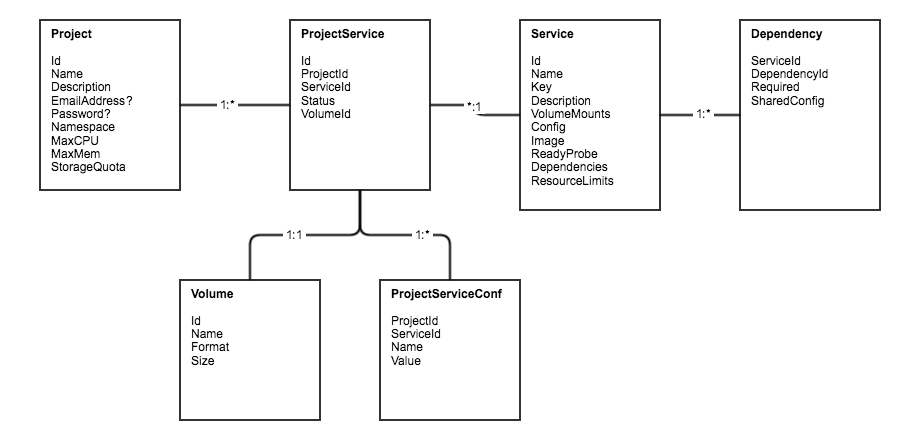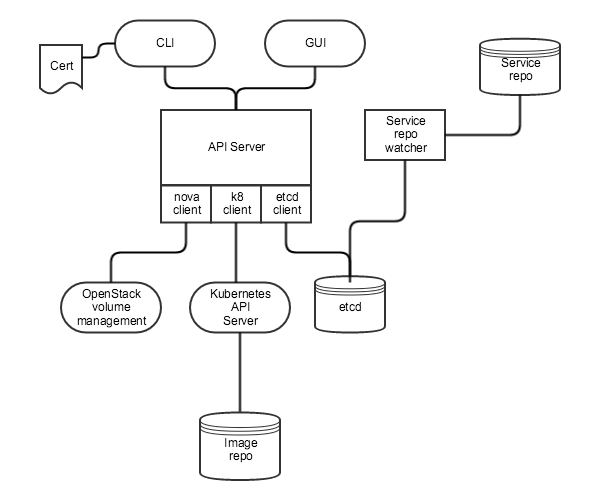Overview
The NDSLabs API is a RESTful interface to the NDSLabs system. The API is implemented via the NDSLabs API Server.
Key Concepts
- Project: A named configuration that relates an administrative user to a set of resource allocations (quotas), and resources (namespace, pods/services, volumes, configurations).
- Application (aka stack): A set of services that are administratively related (i.e., started and stopped together). For example, "clowder" or "dataverse"
- Service specification: A specification of a logical "service" that includes a name, description, storage requirements, configuration options, and relationships to other services. An NDSLabs "service" may be composed of multiple related containers.
- Service library: A collection of service definitions and procedures for adding official/trusted as well as local/development services.
- Application instance: An instance of a service configured and running in a project namespace.
- Resource quota: A set of soft and hard limits assigned to a project (storage and compute).
- Volume mount: A named, allocated storage resource that counts against the project quota and can be mounted by one or more services.
A Simple Use Case
Using the CLI for simplicity: a project administrator wants to add a set of services to their project configuration:
| Command | What it does | Response |
|---|---|---|
| list services | Lists the services in the service library that can be added to this project. |
|
| get service clowder | Gets the service specification | <spec> |
| add service clowder | Adds the specified service to the project | OK |
| set env smtp-host smtp.ncsa.illinois.edu | Sets a configuration option for the named services | OK |
| start clowder | Starts the service | <status> |
| status clowder | Returns the service status | <status> |
| add service image-preview | Adds the specified service to the project | OK |
| start image-preview | Starts the image preview service and updates the clowder service? | <status> |
| stop services | Stops everything | <status> |
Entities
The following is a simple entity-relationship diagram intended to capture the entities, attributes, and relationships for the NDSLabs API.

REST API
For actor definitions, see NDS Labs Use Cases.
Base path: /api/
| Path | Action | Project Admin | Cluster Admin | Notes |
|---|---|---|---|---|
| / | List available paths | GET | GET | |
| /authenticate | PUT | PUT | returns token | |
| /services | List, add site-wide and project-specific services | GET, PUT | PUT | |
| /services/{service-id} | Get, update, delete site-wide services | GET | PUT, DELETE | |
| /services/templates/{service-id}/{service|controller} | Put, get, delete service templates | GET | PUT, DELETE | |
| /projects | List, add projects | GET, PUT | ||
| /projects/{project-id} | Get, update, delete project | GET, PUT | DELETE | |
| /projects/{project-id}/serviceInstances | List, add project services | GET, PUT | ||
| /projects/{project-id}/serviceInstances/{instance-id} | Get, update, delete project service | GET, PUT, DELETE | ||
| /projects/{project-id}/serviceInstances/{instance-id}/status | Get, update, delete project services status | GET, PUT, DELETE | start, stop, restart | |
| /projects/{project-id}/serviceInstance/{instance-id}/config | Get, update, delete service configurations | GET, PUT, DELETE | ||
| /projects/{project-id}/volumes | List, add project volumes | GET, PUT | ||
| /projects/{project-id}/volumes/{volume-id} | Get, update, delete project volumes | GET, PUT, DELETE | ||
| /projects/{project-id}/{stack-id} | Get, update, delete service stack | GET, PUT, DELETE | ||
| /projects/{project-id}/{stack-id}/actions/{action} | Start/Stop a stack | GET,PUT | ||
| /projects/{project-id}/{stack-id}/services/{service-id} | Get, update, delete services in a stack | GET, PUT, DELETE | ||
| /version | Get server version | GET | GET | |
| /refresh_token | Get a new token | GET | GET | |
| /register | Post a new project | POST | ||
| /console | Get a Websocket connection to a console | GET |
The latest version of the API specification is available in Github:
https://github.com/nds-org/ndslabs/blob/master/apis/swagger-spec/ndslabs.yaml
This can be opened using the Swagger editor demo http://editor.swagger.io/, if desired.
Authentication
The API Server currently uses the JSON Web-Token (JWT) approach. The basic flow is as follows:
- POST to /authenticate
- {"username": "demo", "password": "12345"}
- response
{"token": "eyJhbGciOiJIUzI1NiIsInR5cCI6IkpXVCJ9.eyJleHAiOjE0NTY4NzE3ODgsImlkIjoiZGVtbyIsIm9yaWdfaWF0IjoxNDU2ODY5OTg4fQ.pJ2CQyqXDV675KrAtz3qVzwbM7k-tnZ28Pc0o81GtGU"}
- For all subsequent requests, include the following header:
Authorization: Bearer TOKEN
- To refresh the token, simply GET /refresh_token, this will retrieve an updated token
Volumes
- If development environment, creating a volume is just a mkdir on some local path
- If production environment, creating a volume requires a call to the Openstack API (Create, Attach) then a local call to mkfs, then a call to the Openstack API (Detach)
API Server (prototype)
The prototype NDSLabs API Server will be used by the CLI and GUI applications.
Components
We envision the following components:
- CLI
- API Server (either a Jetty application or Go server)
- etcd: Store for service library, project definitions, and services
- Kubernetes API client (for interaction with Kubernetes services, etc).
- Openstack client to handle volume allocation/initialization tasks

API Authentication
- For the CLI, we could follow the Kubernetes API server authentication model using client certificates. They use openssl/easyrsa to sign client certificates where the common name is the username (or in our case, project namespace).
- This is not useful for the GUI, which might require user authentication. Perhaps we can pre-generate a password?
Service definitions
How will we manage service definitions going forward so that new services can be added without requiring access to the nds-labs repository? We need to handle two cases: official or trusted services and services under development. The Docker model might suit us: official service definitions are stored in an SCM repo. A repo watcher polls HEAD for changes and imports new definitions into the service library (e.g., etcd). We can use pull requests to handle trust and verification. To handle development, we could store "draft" definitions in a way that are only accessible to a specific project. For example, the developer could issue "cli add service -f myservice.spec" and the service would be added to services/{namespace} or namespace/services. The "cli list services" would return both official and project-local definitions.